
Reference Guide for the Model RP114 Web Safe Router
.
Table | Menu 3.2 - TCP/IP and DHCP Setup Fields | |
|
|
|
Field |
| Description |
|
|
|
DHCP: |
| If set to Server, the router acts as a DHCP server. |
|
| If set to None, the router’s DHCP server is disabled. |
DHCP Configuration: |
| |
Client IP Pool Starting | This field is the beginning of the range of addresses to assign. | |
Address |
|
|
Size of Client IP Pool | This field is the number of sequential addresses available for | |
|
| assignment to attached hosts. The maximum is 32. |
Primary DNS Server | If you want the router to provide the Primary DNS Server address to | |
|
| attached hosts, enter the DNS address in this field. If this field is 0.0.0.0, |
|
| the router assigns its own address as DNS Server, and performs a DNS |
|
| Proxy if it can obtain a DNS address from the ISP. |
Secondary DNS Server | If you want the router to assign the Secondary DNS Server address | |
|
| to attached hosts, enter the address in this field. |
|
|
|
TCP/IP Setup: |
|
|
IP Address |
| Enter the IP address of the LAN interface of the router in |
|
| notation (four |
|
| for example, 192.168.0.1). Every device on the TCP/IP network must |
|
| have a unique IP address. |
IP Subnet Mask | An IP address consists of two parts, the network ID and the host ID. The | |
|
| IP Subnet Mask specifies the network ID portion of the address, written |
|
| in |
|
| for the class of the IP address that you assign. Unless you have a |
|
| special need for subnetting, use the default subnet mask calculated by |
|
| the router. All hosts on the LAN segment should use the same mask. |
RIP Direction |
| This parameter determines how the router handles RIP (Routing |
|
| Information Protocol). RIP allows the router to exchange routing |
|
| information with other routers. If set to None (default), the router does |
|
| not participate in any RIP exchange with other routers. If set to Both, the |
|
| router broadcasts the routing table of the router on the LAN and |
|
| incorporates RIP broadcasts by other routers into its routing table. If set |
|
| to In Only, the router broadcasts its routing table on the LAN. If set to |
|
| Out Only, the router broadcasts its routing table, but it ignores any RIP |
|
| broadcast packets that it receives. Usually, you should leave this |
|
| parameter at the default (None). |
|
|
|
Using the Manager Interface for Initial Router Configuration |
